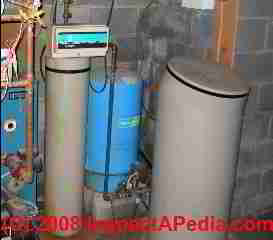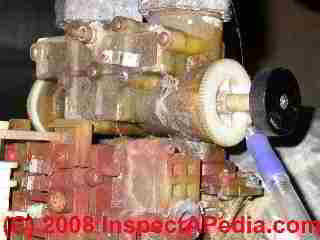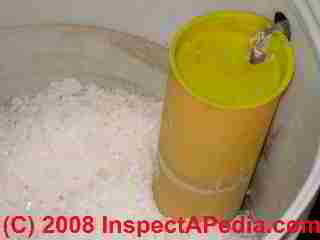 Water Softener Winterizing Guide
Water Softener Winterizing Guide
How to Freeze-Protect a Water Softener
- POST a QUESTION or COMMENT about how to take a water softener out of service & how to protect a water softener from freeze damage
Water softener winterizing procedure:
This article describes how to protect a water softener from freeze damage. Installation instructions for a water softener typically state "Do not install the unit where it might freeze, or next to a water heater or furnace or in direct sunlight." - - Culligan.
But what should be done if a building is going to be shut down and exposed to freezing conditions? The articles in this series will answer most questions about water softeners, water treatment equipment, and about freeze protection for piping and other building plumbing and heating system components: how to winterize a building to avoid frozen pipes, and how to thaw frozen water supply & drain piping, wells, & water tanks.
InspectAPedia tolerates no conflicts of interest. We have no relationship with advertisers, products, or services discussed at this website.
How to Winterize a Water Softener or other Water Treatment Equipment
Watch out: Protect your water conditioner and the entire drain line from freezing temperatures. DANGER: If your water softener should freeze, do not attempt to disassemble it. Call your water softener dealer. [Paraphrasing advice from Culligan.]
Even if you are leaving heat turned on in an unoccupied building during winter, it still makes sense to turn off the water softener:
- No one is using any water, so it does not need to regenerate itself with a water softener ion-exchanger brine rinse cycle, and if you leave the water softener operating, if it's like most "dumb" water softeners that recharge themselves based on a simple clock mechanism, you're wasting water, salt, and energy.
If your water softener is a model that actually monitors water usage and water hardness (such as the Culligan Soft-Minder®), it should not be running itself through a regenerating cycle when the building is empty - no one is using any water.
Still we can protect the equipment and the building from a possible leak by turning it off. - There is the risk of a cold-weather caused or other malfunction or a frozen pipe that could flood the building when the water softener is back-washing and re-charging itself.
Two water softener winterizing steps if you are leaving HEAT ON:
1. Just unplug the electrical power to the water softener, or if it is "hard wired" to an electrical power source, turn off the electrical power switch feeding power to the device.
If the water softener has a manual bypass valve (photo at left), put the valve into bypass position so the softener is not in the piping loop at all.
The water softener bypass valve is normally included as part of the control valve assembly on top of the water softener media tank (the smaller tank that handles the actual ion exchange that is the real work of a water softener).
Bypassing the water softener and turning it off when the building water supply is not going to be in use removes one more possible source of freeze and or leak damage and it also isolates the water softener equipment from the rest of the building water supply piping.
Remember that when you return the water softener to service it will be appropriate to clean and sanitize it. See WATER SOFTENER CLEANING & SANITIZING.
Additional water softener winterizing step if you are turning HEAT OFF in a freezing climate
- Drain the water softener media tank (ion exchanger tank): If heat is to be turned off, drain the water softener or other water treatment equipment as part of the sequence we detail
at WINTERIZE - HEAT OFF PROCEDURE
Look at the instructions for your water softener, or if you don't have them, you can usually obtain a water softener user's guide and installation guide for your water softener by contacting the manufacturer such as the Culligan Corporation or Kemco.
Manufacturers want their products to work well and be successful, and will be happy to provide you with maintenance and freeze-proofing instructions for your water softener. - Drain the water softener control valve?: The control valve on modern water softeners is often constructed of a reinforced thermoplastic.
Watch out: your water conditioner model may have a drain plug that needs to be removed from the water softener control to help assure that that device is not damaged by freezing. - See WATER TURN OFF? for other details about deciding if it is ok or not to shut down a building's water supply.
Steps in Water Softener Draining Procedure
The following advice is adapted and expanded from Water Softener Draining Procedure, in American Aqua HELLENBRAND H-100 Series WATER SOFTENER MANUAL [PDF].
Other water softener draining and winterizing instructions organized by brand and model water softener are found at WATER CONDITIONER / SOFTENER MANUALS
In cold weather climates it is common for plumbing systems that are not in use to be “winterized“ or drained of all water to prevent any damage that may be caused by the excessive expansion of water when it freezes. To prevent damage to a water softener it must be properly drained also.
A simple way to properly drain or winterize a water softener is to use compressed air to force all of the water out of the softener mineral tank. The following procedure will explain the process:
- Initiate the softener into a manual regeneration cycle.
If you don't know how to do that, see WATER SOFTENER MANUAL REGENERATION
After the refill cycle, advance control to backwash and allow it to complete the backwash cycle (this will clean the media) and start into the brine-draw cycle.
Allow the regeneration to continue in the brine draw cycle until the brine is drawn out of the salt tank and the air check at the bottom of the brine pick-up tube shuts off.
NOTE: Be sure you have salt in the brine tank and allow 1 hour minimum to make a saturated brine.
It is important that any liquid left in the softener tank when you finished blowing out system be saturated brine solution to prevent any damage to the softener. At this time no more brine is introduced into the softener and the slow rinse process begins. - Turn the water supply inlet and outlet valves off to the water softener as soon as the air check shuts off and no more brine is being drawn into the softener (at the beginning of the slow rinse process).
- Unplug the electric power leaving the softener control valve in the brine draw cycle.
- Remove the brine refill elbow assembly from the control valve.
Remove the refill flow control retainer assembly from the elbow.
Reinstall the elbow assembly and secure with the locking clip.
Disconnect the brine tube at the top of the salt keeper and force air into the brine tube toward the softener mineral tank and control valve.
The air will force the brine/water solution that was drawn into the mineral tank out to drain through the control valve drain line.
(An air compressor blow gun attachment with a portable air compressor works well.) Reinstall the brine line flow control retainer in side of the refill elbow assembly. Reinstall the brine refill elbow assembly and secure with locking clip.
CAUTION: You do not want to apply any more pressure than necessary to force the brine/water out of the mineral tank.
The small amount of brine/water that may be left in the mineral tank will not expand enough to cause any damage to the softener when it freezes.
If your softener is equipped with an optional bottom drain on the mineral tank, you will have to follow all of the same procedures with the exception of the need for compressed air.
With the brine tube disconnected from the salt keeper, raise it to a level above the softener control valve and temporarily secure it in this position. - Now open the drain valve at the bottom of the mineral
tank and allow all brine/water to drain from the mineral tank.
Watch out: If a hose is connected to the drain valve to direct the brine/water to a floor drain be sure it runs downward and is unobstructed.
When brine/water quits running at the drain, be sure to leave the drain valve open until you start the system up again. - At this time the salt keeper has very little water left in it. What
liquid is left in the salt keeper is saturated brine, provided that
there is still salt left in the tank.
Saturated brine will not freeze solid and cause any damage and does not have to be drained any further from the brine tank.
If there is no salt left in the salt keeper [i.e. the brine tank] when the system is drained we recommend dumping all of the water out of the brine tank at this time.
See brine tank cleaning instructions in your water softener manual, and see WATER SOFTENER CLEANING & SANITIZING. - Watch out: It is important at this time to be assured that the inlet/
outlet water supply piping is properly drained.
Depending on how the water supply piping was routed to the water softener control valve, a water loop or trap may have been created.
Sometimes drain valve(s) are installed at the bottom of the loop to assure all water can be drained out. If not it may be necessary to disconnect the control valve from the piping system and open the inlet/outlet valve(s) to allow all the water to drain from the piping.
This should be done after the rest of the plumbing system is drained. - Draining or winterizing of your softener is complete.
See the start-up procedures in your water softener manual and also see DE-WINTERIZE WATER SOFTENER when you are ready to start your softener.
Do we need to get all water out of the water softener salt storage tank (the brine tank) during winterizing?
At what temperature will a water softener salt tank freeze?
Water inside the treatment tank of a water softener (the smaller-diameter tanks in our photos above) has very little dissolved salt and will freeze at a point at or perhaps just very slightly below freezing - 32 degF. or below.
But the freeze risk in the salt tank (photo at left) is less unless your water softener is going to be exposed to temperatures below zero F or below -21 C.
The water at the bottom of a water softener salt tank is probably close to fully saturated with salt - that is, it's as salty as it can get (23.3% salt) since it has a ready supply of un dissolved salt crystals or tablets (photo at left).
Water that is fully salt-saturated freezes at -21 deg. C or about six degrees below zero Fahrenheit (-5.8 degF).
Still the softener body water pipes feeding the water softener could freeze and break and should be drained.
If your water softener is going to be exposed to temperatures below -5 F (21 degC) it's a good idea to get empty the tank. If the salt tank is plastic (most of them are) and only an inch of water remains in the tank bottom, the chances that the salt tank will be broken and damaged by freezing is certainly less than with a higher amount of water there.
And of course if your water softener salt tank happens to be out of salt we can guess that the water in that tank is less salty and is at a greater risk of freezing which could damage the tank or the float mechanism in the tank (the yellow tube in our photo).
Should we pour antifreeze into the water softener?
Since it's difficult to drain some water treatment equipment folks have asked about using antifreeze instead.
Reader Question: We have been told as inspectors to pour antifreeze into the water softener. What is your reply. Thanks. - Gerald Best 5/7/12
Reply: No.
Gerald, what was that person THINKING ? While indeed there are some antifreeze products that are not toxic, this is not a safe nor recommended procedure for treating water conditioning equipment.
See ANTIFREEZE for BOILERS if you need to know about boiler or other non-potable-water-containing system antifreeze protection.
Why would you pour anything non-potable, much less potentially fatally poisonous into a tank whose contents are going to be sent through treatment equipment that in turn will place it in contact with the building water supply?
We must have mis-understood something along the way in this matter.
But presuming we are talking about pouring antifreeze into the salt tank, fantisizing that doing so winterizes the water softener when that liquid passes back through the softener itself during a regen cycle, or worse that we are talking about pouring antifreeze directly into the resin tank or treatment tank (most do not have an opening that would permit that step) all I can say is
Watch out: DO NOT POUR ANTIFREEZE or anything else that could be toxic into equipment that is treating the building water supply.
There are food-grade anti-freeze products used in RV's, water storage tanks, etc. but even that treatment will be difficult to flush out of a water softener brine tank and still more difficult to flush out of a water softener treatment tank.
Other water treatment equipment needs to be winterized
If your building includes other water treatment equipment such as a chlorinator, UV-light for bacteria in water, or a treatment system for odors or sediment, and if the building heat is going to be turned off, that equipment needs to be drained and protected against freezing.
Similarly if a water pump, pressure tank, expansion tank or other water-containing equipment are exposed to freezing they should either be protected against freezing or they should be drained completely.
Restoring the water softener to operation
The process of returning a water softener to service are detailed in a separate article
at WATER SOFTENER / TREATMENT TURN-ON
...
Continue reading at WINTERIZE - HEAT ON PROCEDURE or select a topic from the closely-related articles below, or see the complete ARTICLE INDEX.
Or see these
Water Softener Articles
- HEAT SOURCES to AVOID FROZEN PIPES
- BYPASS VALVE on WATER SOFTENERS
- DE-WINTERIZE WATER SOFTENER
- WATER SOFTENER ADJUSTMENT & CONTROLS
- WATER SOFTENER CLEANING & SANITIZING
- WATER SOFTENER MANUAL REGENERATION
- WATER CONDITIONER / SOFTENER MANUALS
- WINTERIZE - HEAT OFF PROCEDURE
Suggested citation for this web page
WATER SOFTENER / TREATMENT TURN OFF at InspectApedia.com - online encyclopedia of building & environmental inspection, testing, diagnosis, repair, & problem prevention advice.
Or see this
INDEX to RELATED ARTICLES: ARTICLE INDEX to BUILDING FREEZE PROTECTION
Or use the SEARCH BOX found below to Ask a Question or Search InspectApedia
Ask a Question or Search InspectApedia
Try the search box just below, or if you prefer, post a question or comment in the Comments box below and we will respond promptly.
Search the InspectApedia website
Note: appearance of your Comment below may be delayed: if your comment contains an image, photograph, web link, or text that looks to the software as if it might be a web link, your posting will appear after it has been approved by a moderator. Apologies for the delay.
Only one image can be added per comment but you can post as many comments, and therefore images, as you like.
You will not receive a notification when a response to your question has been posted.
Please bookmark this page to make it easy for you to check back for our response.
Our Comment Box is provided by Countable Web Productions countable.ca
Citations & References
In addition to any citations in the article above, a full list is available on request.
- Mark Cramer Inspection Services Mark Cramer, Tampa Florida, Mr. Cramer is a past president of ASHI, the American Society of Home Inspectors and is a Florida home inspector and home inspection educator. Contact Mark Cramer at: 727-595-4211 mark@BestTampaInspector.com 11/06
- Roger Hankey is principal of Hankey and Brown Inspections, Winter Park, CO. Mr. Hankey is a past chairman of the ASHI Standards Committee and served in other ASHI chapter and national leadership roles. Mr. Hankey is a National Radon Proficiency Program certified measurement professional and a Level II infrared thermographer. Contact Roger Hankey at: 970-393-6604 - rogerhankey47@gmail.com . Website: www.HankeyandBrown.com Mr. Hankey is a frequent contributor to InspectAPedia.com.
- In addition to citations & references found in this article, see the research citations given at the end of the related articles found at our suggested
CONTINUE READING or RECOMMENDED ARTICLES.
- Carson, Dunlop & Associates Ltd., 120 Carlton Street Suite 407, Toronto ON M5A 4K2. Tel: (416) 964-9415 1-800-268-7070 Email: info@carsondunlop.com. Alan Carson is a past president of ASHI, the American Society of Home Inspectors.
Thanks to Alan Carson and Bob Dunlop, for permission for InspectAPedia to use text excerpts from The HOME REFERENCE BOOK - the Encyclopedia of Homes and to use illustrations from The ILLUSTRATED HOME .
Carson Dunlop Associates provides extensive home inspection education and report writing material. In gratitude we provide links to tsome Carson Dunlop Associates products and services.




